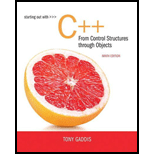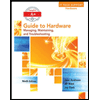
Starting Out with C++ from Control Structures to Objects (9th Edition)
9th Edition
ISBN: 9780134498379
Author: Tony Gaddis
Publisher: PEARSON
expand_more
expand_more
format_list_bulleted
Textbook Question
Chapter 12.10, Problem 12.10CP
Describe the difference between the seekg and the seekp functions.
Expert Solution & Answer
Want to see the full answer?
Check out a sample textbook solution
Students have asked these similar questions
I need to define and discuss the uses of one monitoring or troubleshooting tool in Windows Server 2019. thank you
I would likr toget help with the following concepts:
- Windows Server features
- Windows Server versus Windows 10 used as a client-server network
I need to define and discuss the uses of one monitoring or troubleshooting tool in Windows Server 2019. thank you
Chapter 12 Solutions
Starting Out with C++ from Control Structures to Objects (9th Edition)
Ch. 12.1 - Which file access flag would you use if you want...Ch. 12.1 - Prob. 12.2CPCh. 12.1 - Assuming diskInfo is an fstream object, write a...Ch. 12.1 - Assuming diskInfo is an fstream object, write a...Ch. 12.1 - Assuming diskInfo is an fstream object, write a...Ch. 12.1 - Write a statement that defines an fstream object...Ch. 12.5 - Assume the file input.txt contains the following...Ch. 12.5 - Describe the difference between reading a file...Ch. 12.5 - What will be stored in the file out.txt after the...Ch. 12.10 - Describe the difference between the seekg and the...
Ch. 12.10 - Describe the difference between the tellg and the...Ch. 12.10 - Describe the meaning of the following file access...Ch. 12.10 - What is the number of the first byte in a file?Ch. 12.10 - Briefly describe what each of the following...Ch. 12.10 - Describe the mode that each of the following...Ch. 12 - What capability does the fstream data type provide...Ch. 12 - Which file access flag do you use to open a file...Ch. 12 - Assume the file data.txt already exists, and the...Ch. 12 - How do you combine multiple file access flags when...Ch. 12 - Should file stream objects be passed to functions...Ch. 12 - Under what circumstances is a file stream objects...Ch. 12 - Under what circumstances is a file stream objects...Ch. 12 - Under what circumstances is a file stream objects...Ch. 12 - How do you read the contents of a text file that...Ch. 12 - What arguments do you pass to a file stream...Ch. 12 - What arguments do you pass to a file stream...Ch. 12 - Prob. 12RQECh. 12 - Prob. 13RQECh. 12 - How do you get the byte number of a files current...Ch. 12 - If a program has read to the end of a file, what...Ch. 12 - How do you determine the number of bytes that a...Ch. 12 - How do you rewind a sequential-access file?Ch. 12 - The _____ file stream data type is for output...Ch. 12 - If a file fails to open, the file stream object...Ch. 12 - The same formatting techniques used with...Ch. 12 - The _____ function reads a line of text from a...Ch. 12 - The ____________ member function reads a single...Ch. 12 - The ________member function writes a single...Ch. 12 - Prob. 24RQECh. 12 - __________ files contain data formatted as...Ch. 12 - Prob. 26RQECh. 12 - Prob. 27RQECh. 12 - The ___________ member function writes raw binary...Ch. 12 - The __________ member function reads raw binary...Ch. 12 - Prob. 30RQECh. 12 - In ___________ file access, the contents of the...Ch. 12 - In __________ file access, the contents of a file...Ch. 12 - The _____________ member function moves a files...Ch. 12 - The ___________ member function moves a files...Ch. 12 - The __________ member function returns a files...Ch. 12 - The ___________ member function returns a files...Ch. 12 - The __________ mode flag causes an offset to be...Ch. 12 - The __________ mode flag causes an offset to be...Ch. 12 - The ________ mode flag causes an offset to be...Ch. 12 - A negative offset causes the files read or write...Ch. 12 - Write a statement that defines a file stream...Ch. 12 - Write two statements that use a file stream object...Ch. 12 - Write two statements that use a file stream object...Ch. 12 - Write two statements that use a file stream object...Ch. 12 - Write a program segment that defines a file stream...Ch. 12 - Write code that opens the file data.txt for both...Ch. 12 - Write code that determines the number of bytes...Ch. 12 - The infoFile file stream object is used to...Ch. 12 - T F Different operating systems have different...Ch. 12 - T F fstream objects are only capable of performing...Ch. 12 - T F ofstream objects, by default, delete the...Ch. 12 - T F ifstream objects, by default, create a file if...Ch. 12 - T F Several file access flags may be joined by...Ch. 12 - T F A file may be opened in the definition of the...Ch. 12 - T F If a file is opened in the definition of the...Ch. 12 - T F A file stream objects fail member function may...Ch. 12 - T F The same output formatting techniques used...Ch. 12 - T F The operator expects data to be delimited by...Ch. 12 - T F The getline member function can be used to...Ch. 12 - T F It is not possible to have more than one file...Ch. 12 - T F Binary files contain unformatted data, not...Ch. 12 - T F Binary is the default mode in which files are...Ch. 12 - T F The tellp member function tells a file stream...Ch. 12 - T F It is possible to open a file for both input...Ch. 12 - fstream file(ios::in | ios::out);...Ch. 12 - ofstream file; file.open (info.dat, ios::tin); if...Ch. 12 - fstream file("info.dat"); if (!file) { cout ...Ch. 12 - fstream dataFile("info.dat", ios:in | ios:binary);...Ch. 12 - Prob. 69RQECh. 12 - fstream dataFi1e("info.dat", ios:in); char...Ch. 12 - Prob. 71RQECh. 12 - fstream inFile("info.dat", ios:in); int x;...Ch. 12 - File Head Program Write a program that asks the...Ch. 12 - File Display Program Write a program that asks the...Ch. 12 - Punch Line Write a program that reads and prints a...Ch. 12 - Tail Program Write a program that asks the user...Ch. 12 - Line Numbers (This assignment could be done as a...Ch. 12 - String Search Write a program that asks the user...Ch. 12 - Sentence Filter Write a program that asks the user...Ch. 12 - Array/File Functions Write a function named...Ch. 12 - File Encryption Filter File encryption is the...Ch. 12 - File Decryption Filter Write a program that...Ch. 12 - Prob. 11PCCh. 12 - Prob. 12PCCh. 12 - Inventory Program Write a program that uses a...Ch. 12 - Inventory Screen Report Write a program that reads...Ch. 12 - Average Number of Words If you have downloaded...Ch. 12 - Customer Accounts This program should be designed...
Additional Engineering Textbook Solutions
Find more solutions based on key concepts
Porter’s competitive forces model: The model is used to provide a general view about the firms, the competitors...
Management Information Systems: Managing The Digital Firm (16th Edition)
This optional Google account security feature sends you a message with a code that you must enter, in addition ...
SURVEY OF OPERATING SYSTEMS
What three things are listed on an IPO chart?
Starting Out with Python (4th Edition)
Fill in the blanks in each of the following statements: A relation that has no partial functional dependencies ...
Modern Database Management
Describe how the average of a collection of numbers can be computed more rapidly with a multiprocessor machine ...
Computer Science: An Overview (13th Edition) (What's New in Computer Science)
In Exercises 41 through 46, identify the errors. Dim9WAsDouble9W=2*9WIstoutput.Items.Add(9W)
Introduction To Programming Using Visual Basic (11th Edition)
Knowledge Booster
Learn more about
Need a deep-dive on the concept behind this application? Look no further. Learn more about this topic, computer-science and related others by exploring similar questions and additional content below.Similar questions
- Please solve and answer the questions correctly please. Thank you!!arrow_forwardConsidering the TM example of binary sum ( see attached)do the step-by-step of execution for the binary numbers 1101 and 11. Feel free to use the Formal Language Editor Tool to execute it; Write it down the current state of the tape (including the head position) and indicate the current state of the TM at each step.arrow_forwardI need help on inculding additonal code where I can can do the opposite code of MatLab, where the function of t that I enter becomes the result of F(t), in other words, turning the time-domain f(t) into the frequency-domain function F(s):arrow_forward
arrow_back_ios
SEE MORE QUESTIONS
arrow_forward_ios
Recommended textbooks for you

 EBK JAVA PROGRAMMINGComputer ScienceISBN:9781337671385Author:FARRELLPublisher:CENGAGE LEARNING - CONSIGNMENT
EBK JAVA PROGRAMMINGComputer ScienceISBN:9781337671385Author:FARRELLPublisher:CENGAGE LEARNING - CONSIGNMENT Systems ArchitectureComputer ScienceISBN:9781305080195Author:Stephen D. BurdPublisher:Cengage Learning
Systems ArchitectureComputer ScienceISBN:9781305080195Author:Stephen D. BurdPublisher:Cengage Learning A+ Guide to Hardware (Standalone Book) (MindTap C...Computer ScienceISBN:9781305266452Author:Jean AndrewsPublisher:Cengage LearningCOMPREHENSIVE MICROSOFT OFFICE 365 EXCEComputer ScienceISBN:9780357392676Author:FREUND, StevenPublisher:CENGAGE L
A+ Guide to Hardware (Standalone Book) (MindTap C...Computer ScienceISBN:9781305266452Author:Jean AndrewsPublisher:Cengage LearningCOMPREHENSIVE MICROSOFT OFFICE 365 EXCEComputer ScienceISBN:9780357392676Author:FREUND, StevenPublisher:CENGAGE L


EBK JAVA PROGRAMMING
Computer Science
ISBN:9781337671385
Author:FARRELL
Publisher:CENGAGE LEARNING - CONSIGNMENT

Systems Architecture
Computer Science
ISBN:9781305080195
Author:Stephen D. Burd
Publisher:Cengage Learning


A+ Guide to Hardware (Standalone Book) (MindTap C...
Computer Science
ISBN:9781305266452
Author:Jean Andrews
Publisher:Cengage Learning

COMPREHENSIVE MICROSOFT OFFICE 365 EXCE
Computer Science
ISBN:9780357392676
Author:FREUND, Steven
Publisher:CENGAGE L
C - File I/O; Author: Tutorials Point (India) Ltd.;https://www.youtube.com/watch?v=cEfuwpbGi1k;License: Standard YouTube License, CC-BY
file handling functions in c | fprintf, fscanf, fread, fwrite |; Author: Education 4u;https://www.youtube.com/watch?v=aqeXS1bJihA;License: Standard Youtube License